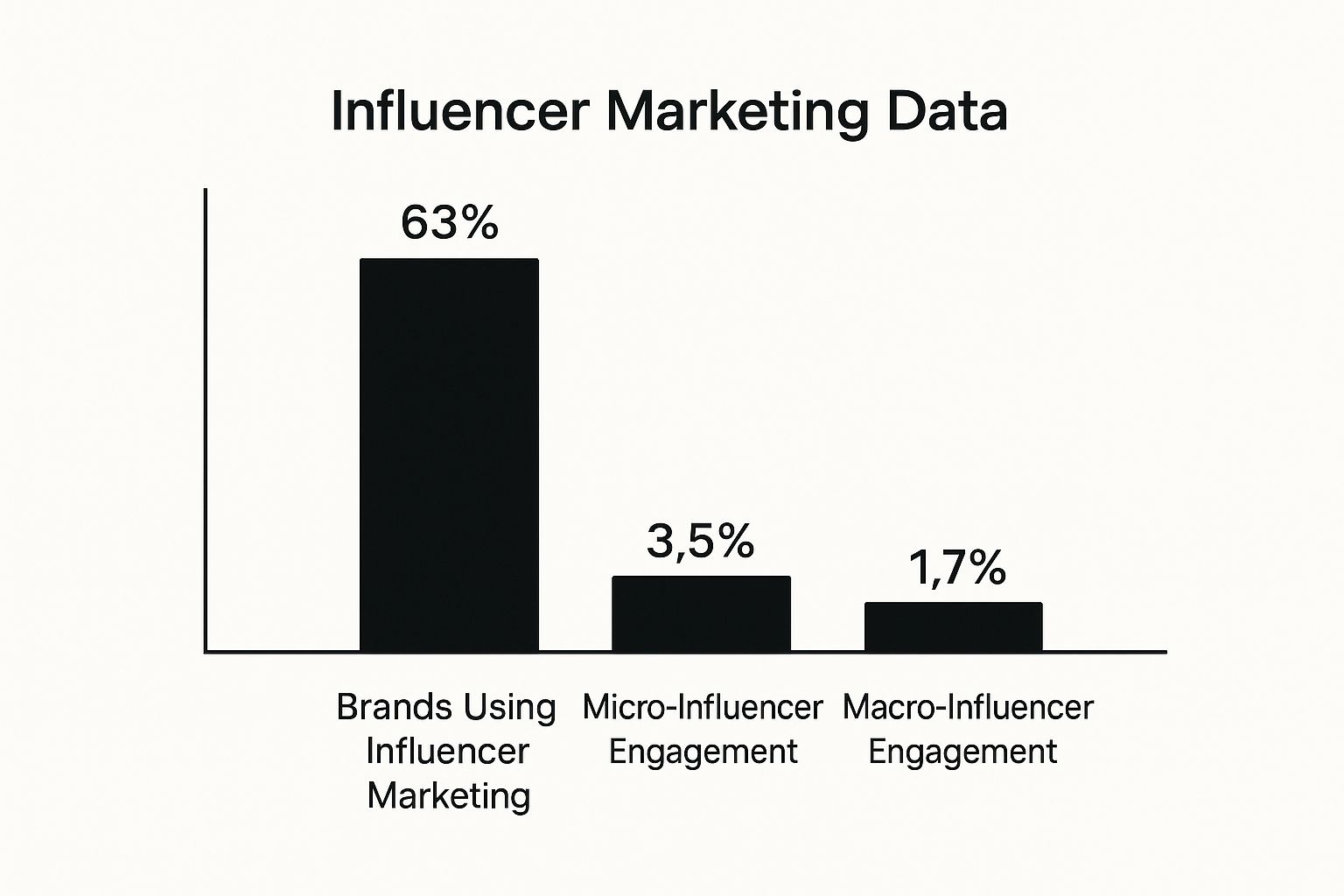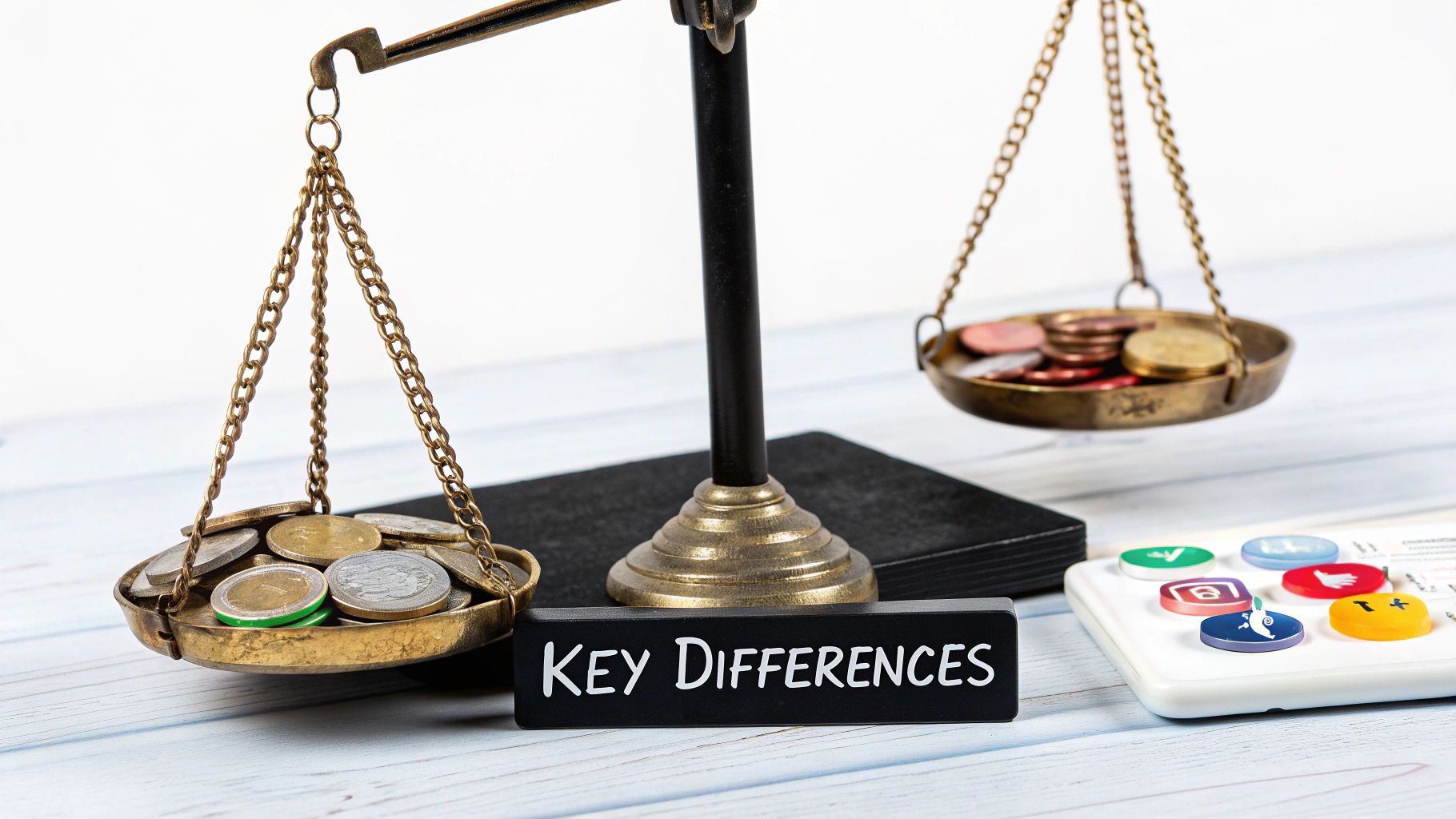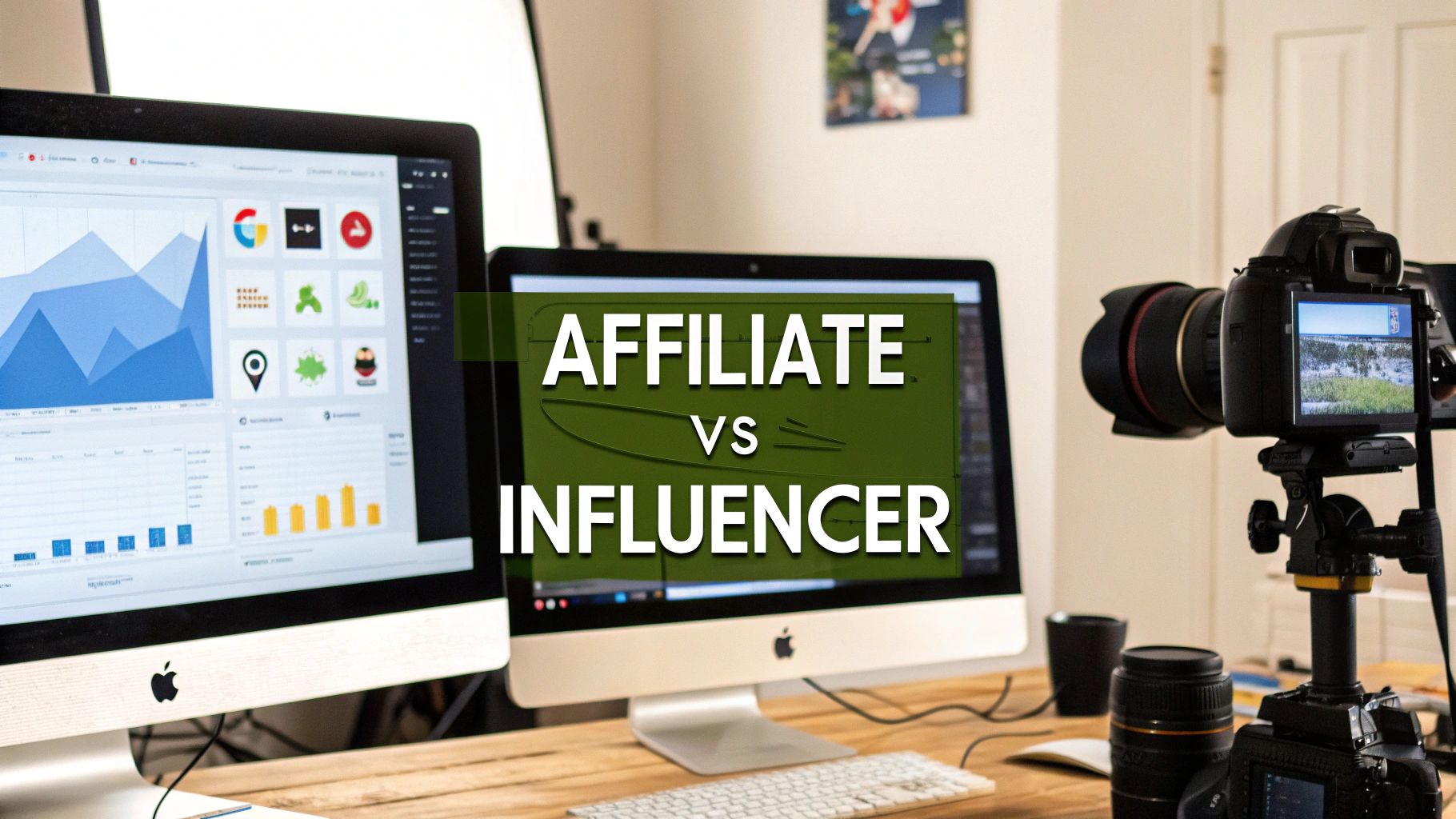Let's get one thing straight right away: affiliate marketing and influencer marketing are not the same thing. The core difference boils down to this: affiliate marketing is a purely transactional play, where partners get paid a commission for driving direct sales. Think of it as a performance-based sales channel.
In contrast, influencer marketing is all about relationships. It’s a strategy focused on using a creator's authenticity and audience trust to build brand awareness. Here, you're often paying upfront for content and exposure, not just for the final sale.
Affiliate And Influencer Marketing: An Overview

Before we jump into the nitty-gritty, it's vital to grasp the unique roles these two marketing powerhouses play. On the surface, they look similar—you partner with people to promote your stuff. But how they work, what they aim to achieve, and how you measure success are worlds apart. Nailing these distinctions is the key to picking the right approach for your brand.
What Exactly Is Affiliate Marketing?
Affiliate marketing runs on a simple, effective "pay-for-performance" model. Brands give unique, trackable links or discount codes to their partners, called affiliates. These partners can be anyone—bloggers, review sites, media publications, you name it. They promote your products, and they only get paid a commission when someone makes a purchase through their specific link.
This makes affiliate marketing an incredibly low-risk, high-ROI channel for getting those bottom-of-the-funnel conversions. You're only paying for actual sales, which makes it easy to manage your budget and scale your efforts.
And it’s a massive force in ecommerce. Affiliate marketing is responsible for about 16% of all online sales across the globe. The industry, valued at $18.5 billion in 2025, is projected to rocket to $31.7 billion by 2031, with North America at the forefront.
And What About Influencer Marketing?
Influencer marketing plays a different game. Its main goal is building brand equity and creating a conversation. Here, businesses team up with social media creators—influencers—who have built a loyal following and a reputation for expertise in a certain niche.
The immediate goal isn't always a sale. It’s about generating buzz, earning social proof, and getting your brand in front of a new, highly engaged audience. If you're looking for a deeper dive, resources on Digital Influencer Marketing can provide a lot more detail.
At-a-Glance: Affiliate vs. Influencer Marketing
To quickly break down the fundamental differences, here's a simple side-by-side comparison. This table helps frame the core distinctions in goals, payment, and overall focus.
| Attribute | Affiliate Marketing | Influencer Marketing |
|---|---|---|
| Primary Goal | Direct Sales & Conversions | Brand Awareness & Trust |
| Payment Model | Commission-Based (Pay-per-Sale) | Upfront Fees & Product Gifting |
| Focus | Transactional (Driving an Action) | Relational (Building Credibility) |
| Risk Level | Low (Pay for confirmed results) | Higher (Investment is upfront) |
Ultimately, one is a sales channel, and the other is a brand-building channel. This is the central idea that shapes everything else, from who you partner with to how you track your results.
Comparing The Core Mechanics And Objectives
To really get to the heart of the affiliate vs. influencer marketing debate, you have to look under the hood. While both are built on partnerships, the way they operate, how people get paid, and what they’re meant to achieve for a business are worlds apart. One is a pure-play sales machine; the other is a brand-building powerhouse.
Affiliate marketing runs on a simple, transactional engine. A partner promotes your product with a unique, trackable link or code. They only get paid when that link leads to a specific action—almost always a sale. This makes it a low-risk, performance-driven channel laser-focused on acquiring customers.
On the flip side, influencer marketing is all about relationships. The core idea is to pay a creator for their content, their reach, and, most importantly, the trust they've cultivated with their audience. The aim isn't just a click or a sale; it's about drumming up awareness, building social proof, and sparking authentic conversations.
Payment Structures And Partnership Dynamics
How you pay your partners says everything about your strategy. Affiliate marketing is defined by its cost-per-acquisition (CPA) model. You pay for results, not for effort.
- Commission-Based: Affiliates earn a set percentage or a flat fee for every single sale they drive.
- Performance Tiers: You can motivate your best partners by offering higher commission rates as they hit certain sales targets.
- Long-Term Payouts: Many programs, especially in SaaS, offer recurring commissions to reward affiliates for bringing in loyal, long-term customers.
Influencer marketing, however, usually requires an upfront investment. You're paying for content creation and access to an engaged community, which naturally comes with a different kind of financial risk.
- Flat Fees: Most influencers have a set price for a post, a story, or a video, which is based on their follower count and engagement metrics.
- Product Gifting: For smaller creators, a partnership might simply involve sending them free products in exchange for a review or a shout-out.
- Hybrid Models: We're seeing a growing trend of combining upfront fees with performance bonuses, which effectively blends the two strategies.
The real difference comes down to risk and reward. Affiliate marketing keeps upfront financial risk low by tying payments directly to revenue. Influencer marketing demands an initial investment based on the belief that brand exposure will ultimately translate into sales.
Analyzing Strategic Objectives And Goals
Your main business goal should be the deciding factor here. Are you chasing immediate, trackable sales, or are you playing the long game of building a brand people love?
The objective of affiliate marketing is crystal clear: drive scalable, low-risk conversions. It’s a bottom-of-the-funnel play designed to capture existing demand and turn potential buyers into paying customers as efficiently as possible. All eyes are on metrics like conversion rates, earnings per click (EPC), and customer lifetime value.
Influencer marketing, meanwhile, shines at the top of the funnel. Its primary job is to build brand affinity, generate authentic content, and get your product in front of fresh eyes. Success here is measured by things like engagement rates, audience sentiment, and brand mentions.
This infographic breaks down some key data points in the influencer space, highlighting brand adoption and where the real engagement is happening.

The data really drives home the point that while many brands are using influencers, the much higher engagement from micro-influencers points to a clear shift toward more authentic, niche partnerships.
To provide a clearer picture, let's break down the strategic differences in a side-by-side comparison.
Detailed Strategic Comparison
| Comparison Point | Affiliate Marketing | Influencer Marketing |
|---|---|---|
| Primary Goal | Direct sales, lead generation, customer acquisition. | Brand awareness, social proof, community engagement. |
| Payment Model | Cost-Per-Acquisition (CPA): Pay-for-performance, commission on sales. | Flat Fee / Gifting: Upfront payment for content and exposure. |
| Risk Factor | Low upfront financial risk; only pay for results. | Higher upfront risk; payment is not tied directly to sales. |
| Content Control | Low. Affiliates create their own content (reviews, ads). | High. Brands collaborate on content to ensure alignment. |
| Relationship | Transactional & scalable. Can manage thousands of partners. | Relational & collaborative. Requires hands-on management. |
| Key Metrics | Conversion Rate, Clicks, EPC, Customer Lifetime Value. | Engagement Rate, Reach, Impressions, Brand Mentions. |
| Funnel Stage | Bottom-of-Funnel: Captures existing demand. | Top/Mid-Funnel: Creates new demand and builds trust. |
This table shows that your choice really depends on whether you need to convert existing interest or generate new buzz from scratch.
Partnership Types And Content Control
The very nature of these partnerships is also quite different. Affiliate relationships are often more hands-off and built for scale. You could have thousands of affiliates you’ve never personally spoken to, all promoting your brand through blogs, newsletters, or review sites. The relationship is less about deep collaboration and more about equipping them with the right tools to sell effectively. If you want to dive deeper into these distinctions, you can explore our guide on the difference between an affiliate vs a partner.
Influencer partnerships, by contrast, are inherently collaborative and need much closer management. Brands work hand-in-hand with creators to make sure the content hits the right messaging points while still feeling genuine to the influencer’s own style. This means a greater degree of creative input and brand involvement is required.
At the end of the day, influencer marketing campaigns are delivering impressive financial results, bringing in an average ROI of $4.12 for every $1 spent on platforms like Instagram. These kinds of ROI-driven statistics show a clear trend: smart brands are increasingly blending influencer partnerships with affiliate-style commission models to tie their spending directly to sales.
How to Measure Performance and Success

When you look at affiliate marketing versus influencer marketing, how you measure success is where you see the biggest difference. One is a pure numbers game, all about clear, trackable results. The other is more of an art, focused on winning hearts and minds, which calls for a much softer set of metrics.
Affiliate marketing's performance is refreshingly simple to track. Because it’s a pay-for-performance model, every metric is tied directly to the bottom line. There’s no guesswork involved—either the numbers work, or they don’t.
Measuring Affiliate Marketing Performance
Tracking an affiliate program is all about the data. The entire goal is to make sure the money an affiliate brings in is way more than the commission you pay them. Good affiliate platforms automate most of this, so you can see exactly who is driving real sales.
Here are the core metrics you'll live by:
- Conversion Rate: This is the big one. It's the percentage of people who click an affiliate link and actually buy something. A high conversion rate means the affiliate is sending you people who are ready to pull out their wallets.
- Earnings Per Click (EPC): EPC tells you how much you make, on average, every single time someone clicks an affiliate’s link. It's a fantastic way to quickly gauge the quality of their traffic.
- Average Order Value (AOV): This metric reveals if your affiliates are attracting big spenders or bargain hunters. An affiliate driving a high AOV is often more valuable than one driving tons of tiny sales.
- Customer Lifetime Value (CLV): This is the ultimate report card. CLV shows you the total profit a customer generates over their entire relationship with you, giving you a long-term view of an affiliate's value.
Keeping a close eye on these numbers lets you double down on your star performers and either help or cut loose the ones who aren't pulling their weight. This data is also crucial for dialing in your spending, a concept we dig into in our guide on how to calculate customer acquisition cost.
Gauging Success in Influencer Marketing
Figuring out if an influencer campaign actually worked is a different beast altogether. While you might track some sales, the real goals are often about building brand awareness and connecting with an audience. Success isn't just a sales report; it's about making a genuine impact.
The real trick with influencer marketing is connecting the dots between brand awareness and actual sales. You have to blend different types of data to get the full story of a campaign's impact.
To do this, marketers use a much wider range of performance indicators.
Top-Funnel Awareness Metrics:
These tell you how well the influencer introduced your brand to new people.
- Reach and Impressions: How many eyeballs saw the content and the total number of times it was viewed.
- Brand Mentions and Share of Voice: Are more people talking about your brand online after the campaign went live?
Mid-Funnel Engagement Metrics:
This is where you see if the content actually hit the mark with the audience.
- Engagement Rate (Likes, Comments, Shares): A high engagement rate is a strong signal that the influencer’s content truly resonated with their followers.
- Audience Sentiment: You need to look at the comments. Are people excited and positive, or are they skeptical? This qualitative feedback is gold.
To get a better handle on direct sales, many brands are now giving influencers unique discount codes or trackable links. This creates a hybrid model, mixing influencer reach with affiliate-style attribution. Using UTM parameters in links is also standard practice, letting you trace website traffic and sales directly back to a specific influencer's post in your analytics. This approach gives you the best of both worlds—the brand-building power of an influencer and the cold, hard data of an affiliate.
Choosing the Right Strategy for Your Business
Figuring out whether to go with affiliate or influencer marketing isn't about which one is "better." It's about picking the right tool for the job at hand. The best choice really comes down to your business stage, what you're selling, and your immediate goals. One is a master at driving measurable sales with little upfront risk; the other is all about building brand love and trust.
The decision really starts with one simple question: Do you need to capture existing demand, or do you need to create it from scratch? Your honest answer will point you in the right direction.
When to Prioritize Affiliate Marketing
Affiliate marketing is the hands-down winner when you need to drive sales in a way that's efficient and predictable. Because it's a performance-based model, it’s the perfect fit for a few specific situations.
Consider leaning into an affiliate strategy if your business is:
- A Bootstrapped E-commerce Startup: When cash flow is tight, you can't throw money at campaigns that might not work. With affiliate marketing, you only pay for actual sales. This makes it a super low-risk way to get those first crucial customers in the door.
- A SaaS Company with a Proven Funnel: If you already know your customer lifetime value and have your conversion rates dialed in, an affiliate program can become a powerful, scalable sales engine. You can set commissions confidently, knowing exactly what each new user is worth to you long-term.
- Focused on a Niche with Strong Search Intent: Are customers actively Googling for solutions like yours? Think software reviews or "best of" lists. If so, affiliates like bloggers and niche review sites are perfectly positioned to capture that high-intent traffic for you.
For businesses going the affiliate route, sending that hard-won traffic to a page that converts is everything. You'll want to build a high-converting landing page for affiliate marketing to make sure your partners' efforts (and your commissions) aren't wasted.
The affiliate world is huge, with giants like Amazon Associates commanding 46.21% of the market share. That shows the power of established networks, but new trends are also making the channel more potent, like AI-powered optimization and using video content, which can bump conversion rates by 49%.
When to Invest in Influencer Marketing
Influencer marketing is your go-to when your main goals are shaping brand perception, earning trust, and building awareness at the top of the funnel. It's less about the immediate sale and more about an investment in your brand's story.
This approach really shines for businesses like:
- A Legacy Brand Needing to Connect with Gen Z: An older, established company can have a tough time seeming authentic to a younger crowd. Partnering with creators that this generation already trusts can instantly bridge that credibility gap.
- A Brand Launching an Innovative Product: When you’ve built something completely new that people don't even know to search for yet, you have to create the demand. Influencers are perfect for showing off a new product's value to an audience that isn't even looking for a solution.
- A Visual or Lifestyle Brand: If you sell fashion, beauty, food, or travel products, seeing them in an aspirational, real-world setting is key. Influencers provide the kind of social proof and visual storytelling that a static ad just can't match.
The core decision hinges on your immediate need. Choose affiliate marketing to capitalize on existing buyer intent with a clear ROI. Opt for influencer marketing to build that intent and brand trust from the ground up.
Of course, finding the right partners is non-negotiable for either strategy. While affiliate programs can often scale with less hands-on management, getting the right publishers on board is still critical. For anyone looking to build out their network, our guide explains how to find bloggers for your program. Every goal demands a different kind of partner, and getting that choice right is fundamental to your success.
How to Integrate Affiliate and Influencer Marketing
The old debate of affiliate vs. influencer marketing treats them like two different highways. But the smartest marketers I know have learned how to build an interchange, connecting the brand-building power of influencers with the conversion-focused engine of affiliate marketing.
Instead of choosing one over the other, a hybrid strategy creates a powerful loop. Influencers generate authentic buzz and get people interested, and your affiliate channels are right there to capture that interest and turn it into measurable sales. It's a beautiful thing when it works together.
Turning Influencers into Performance Partners
The first mental shift is to stop seeing influencers as just a tool for awareness. Many of the best creators are sharp entrepreneurs who would jump at the chance for a long-term, performance-based partnership. The trick is to bring them into your affiliate program.
Instead of just cutting a check for a one-off sponsored post, give them the same tools you’d give a traditional affiliate partner. This creates a win-win: they get a consistent income stream beyond a flat fee, and you get ongoing, authentic promotion that’s tied directly to sales.
Here’s how to make it happen:
- Provide Unique Affiliate Links: Give every influencer their own trackable link. This is non-negotiable, as it’s the only way to see exactly which clicks and sales came from their efforts.
- Create Custom Discount Codes: A personalized code like "SARAHG15" does more than just track sales. It gives their audience a real reason to buy and makes the promotion feel like an exclusive insider deal.
Structuring a Hybrid Compensation Model
For this to work, you need a compensation model that rewards both the creative work and the sales performance. Going to an established influencer with a pure commission offer is a great way to get ignored—they're used to getting paid for their creative efforts upfront.
A balanced approach almost always works best:
- Upfront Fee for Content: Start with a fair, flat fee. This pays them for their time, creative energy, and production costs. It shows you respect them as a creator and secures their commitment.
- Performance-Based Commission: Then, layer a commission on top of that fee. This is what motivates the influencer to not just create a pretty post, but to create content that genuinely drives their audience to buy—and to keep promoting it over time.
This hybrid payment structure is the bridge between the two worlds. It gives the influencer the financial security they need, while giving your brand the low-risk, high-ROI benefit of a true performance partnership.
This integrated thinking is becoming critical. The global influencer marketing industry is projected to hit $32.5 billion by 2025, while the affiliate industry is estimated to reach $12 billion. This shows where the big awareness dollars are going. But here's the kicker: when these strategies are combined, influencer collaborations can lift affiliate sales performance by as much as 46%. It’s proof that top-of-funnel buzz directly fuels bottom-funnel conversions. You can dig into more of these influencer and affiliate marketing projections to see the trend.
Building a Cohesive Marketing Funnel
With an integrated strategy, your funnel stops being a series of separate campaigns and starts acting like a single, well-oiled machine. Each part amplifies the others, creating a continuous cycle of awareness and conversion.
Example Scenario: A SaaS Company
Let’s say a software company is launching a new project management tool. Here's what their integrated funnel could look like:
- Top of Funnel (Awareness): They find a handful of tech influencers on YouTube and pay them an upfront fee to create detailed tutorials. The videos show off the tool’s best features in an authentic, real-world context.
- Middle of Funnel (Consideration): In the video description, each influencer includes their unique affiliate link and a special 20% discount code. This gives their highly engaged audience a tangible reason to click and try the software.
- Bottom of Funnel (Conversion): The affiliate link takes viewers to a co-branded landing page. When someone signs up for a paid plan using that link or code, the influencer earns a recurring 30% commission for the first year of the subscription.
In this model, the influencer's content created the initial trust and excitement. The affiliate link and discount code provided the direct, measurable path to a sale. The brand walked away with valuable user-generated content, powerful social proof, and a stream of new customers acquired through a performance-based channel. That's how you maximize ROI at every single stage.
The Future of Partnership Marketing

The old debate of affiliate vs. influencer marketing is quickly becoming obsolete. The lines aren't just blurring; they're merging into a smarter, more integrated approach to partnerships. The future isn’t about picking one over the other. It's about building a single, cohesive ecosystem where brand awareness and direct sales work hand-in-hand, all powered by new tech and a serious demand for accountability.
Leading this charge is Artificial Intelligence (AI). Far from a buzzword, AI is now a practical tool that's completely changing how brands find and work with partners. Modern platforms can sift through millions of data points to pinpoint the perfect affiliates and influencers, looking past vanity metrics like follower counts to find genuine audience alignment and engagement. This tech also fine-tunes campaigns on the fly, making real-time adjustments to get the best possible results.
The Rise of Performance-Based Authenticity
One of the most interesting shifts we're seeing is how micro and nano-influencers are being brought into performance-based models. These creators have always been champions of authenticity with their tight-knit, super-engaged communities. In the past, though, their value was hard to nail down, often limiting them to top-of-funnel awareness plays.
That's changing. Now, they’re being equipped with affiliate links and custom promo codes, turning their genuine recommendations into measurable sales. Brands are learning that a well-managed network of hundreds of nano-influencers can drive more revenue than a single celebrity-status influencer, particularly when they're paid based on the sales they actually produce. It’s a scalable way to get authentic marketing that truly performs.
The future of partnership marketing is rooted in accountability. Brands are no longer satisfied with impressions and reach; they demand clear, data-backed evidence that connects every dollar spent to a tangible business outcome, from initial awareness to the final sale.
This hunger for clear ROI is pushing the entire industry toward better attribution. As brands demand more measurable outcomes, they're leaning on sophisticated tracking and pulling micro and nano-influencers deeper into their affiliate programs. This whole movement is supported by big steps forward in AI and data analytics, which help justify and optimize every dollar spent. If you're interested in the numbers behind these trends, you can discover more insights on affiliate and influencer statistics.
From Transactions to Long-Term Relationships
Ultimately, the entire field is moving away from short-term, transactional campaigns and toward long-term, strategic partnerships. Brands are finally realizing that the best partners—whether you call them affiliates or influencers—are the ones who become true brand advocates.
This means investing time and effort into building real relationships. It means giving partners better tools and support, and designing payment models that reward loyalty and long-term growth. The end goal is to cultivate an ecosystem of partners who are genuinely invested in your success, creating a growth engine that’s as authentic as it is profitable.
Frequently Asked Questions
When you're weighing affiliate marketing against influencer marketing, a few key questions always seem to pop up. Let's tackle them head-on so you can figure out the right path for your brand.
Can an Influencer Also Be an Affiliate?
Yes, and honestly, this is where the magic really happens. It’s one of the smartest hybrid strategies out there. An influencer can use their authentic voice to get people excited about a product, and then give them a special affiliate link or discount code to make a purchase.
This setup is a win-win. The influencer earns a commission based on their performance, giving them a real stake in the outcome. Meanwhile, the business gets a campaign that both builds brand trust and drives directly trackable sales. It’s the perfect blend of awareness and action.
What’s the Main Difference in Payment?
The biggest difference comes down to when and why you pay. Think of it in terms of risk.
Affiliate marketing is pure performance. You only pay a commission after a sale has been made and verified. It's a transactional, low-risk model where your marketing spend is directly tied to revenue.
Influencer marketing, on the other hand, usually involves paying an upfront fee for the influencer's creative work and access to their audience. You're paying for potential reach and brand association before you see a single sale.
The simplest way to put it is this: You pay affiliates for results, and you pay influencers for their reach and content. Grasping this distinction is crucial when you're planning your marketing budget.
Which Is Better for a New Business with a Small Budget?
If you're just starting out and watching every dollar, affiliate marketing is almost always the safer bet. Since you only pay for confirmed sales, there's no upfront financial gamble. Your marketing costs are directly linked to the money coming in.
This lets you get those critical first sales and build up some cash flow without the risk of paying a big influencer fee and hoping for the best. Once your business is on more solid ground, you can start channeling some of those profits into influencer campaigns to really amplify your brand's reach.
Ready to turn your best customers into powerful growth partners? Refgrow makes it easy to launch a fully native affiliate program inside your SaaS product with just one line of code. Start building your performance-based marketing engine today at https://refgrow.com.

